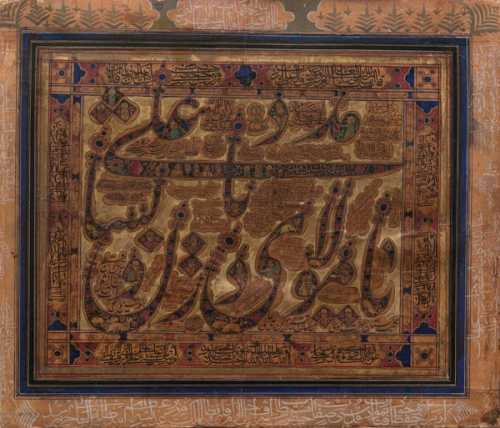Hassan Zaringhalam
Iran | 1863 - 1929About Hassan Zaringhalam
Mirza Hassan Zaringhalam was one of the Qajar-era artists involved in calligraphy, painting, and poetry. His mastery of Haft Ghalam and decorative Tughra calligraphy has made him a unique calligrapher. As a calligrapher, he learned the art from Mirza Taher Katab Homayoun and Emad-ol-Ketab Seifi, and he devoted himself to teaching calligraphy in Tehran schools after becoming famous. He also established his own educational institution on Nasser Khosro Street in Tehran in this regard. As well as being a safe haven for his teaching, it was also a place where he received orders for his calligraphy.
As an artist, he was innovative and talented in selecting and combining different scripts, and by placing religious symbols and signs in his calligraphy frames, he was able to create beautiful works that were eye-catching and decorative. Additionally, he was highly skilled in the art of "Golzar calligraphy." Golzar calligraphy is created when a script such as Nast'aliq is written in coarse jelli (coarse) and then every letter, word, and the entire pen and broad parts are painted and decorated with flowers, leaves, and buds.
A precursor to the art of calligraphic painting in the following years, these decorative works were very popular with Qajar nobles. Several copies of these frames were found in their homes. Mirza Hassan used the holy names of infallible imams, religious figures, kings, dervishes, and famous Sufis in his calligraphy. In addition, this was another factor that contributed to the popularity of his innovative designs and calligraphy among the general public.
His talent with the Persian language was not limited to calligraphy; he also had abilities in prose and poetry and was nicknamed "Taj-ol-Sh'er." Although he was a prolific calligrapher, few of his works have survived. Among them, we can mention the pieces that Mirza named as "Katabeh Hasan Zaringhalam, October 1882", "Hassan Zaringhalam 1893, 1892, 1890, 1887", "Khanezad Astan Homayun... Hassan Zaringhalam, Madah Rekab... Naser al-Din Shah", "Inscription and manuscript... Hasan Zaringhalam... 1888" and "... the month of February 1895 Hasan Zaringhalam... during the reign of the government... Mozafar al-Din Shah". These works have tremendous technical variety and include Nasta'liq, Naskh, Thuluth, Taliq, Tauqi, Tughrai, and broken Nasta'liq scripts, with Shesh Dung, Ghobarkhosh and Motevasset techniques.
The Most Expensive Artwork
At Auctions
First Attendance
29 May 2015
# Attendance
4
# Artworks
5
Average Realized Price
49,744 USD
Average Min Estimate
15,621 USD
Average Max Estimate
21,189 USD
Sell-through Rate
100%
Average Growth of Artwork Worth
150.304%
Timeline
The 19th Tehran -Classic and Modern Iranian Art auction
24 January
یازدهمین دوره حراج تهران auction
5 July
The 9th Tehran- Classic and Modern Iranian Art auction
29 June
چهارمین دوره حراج تهران auction
29 May
